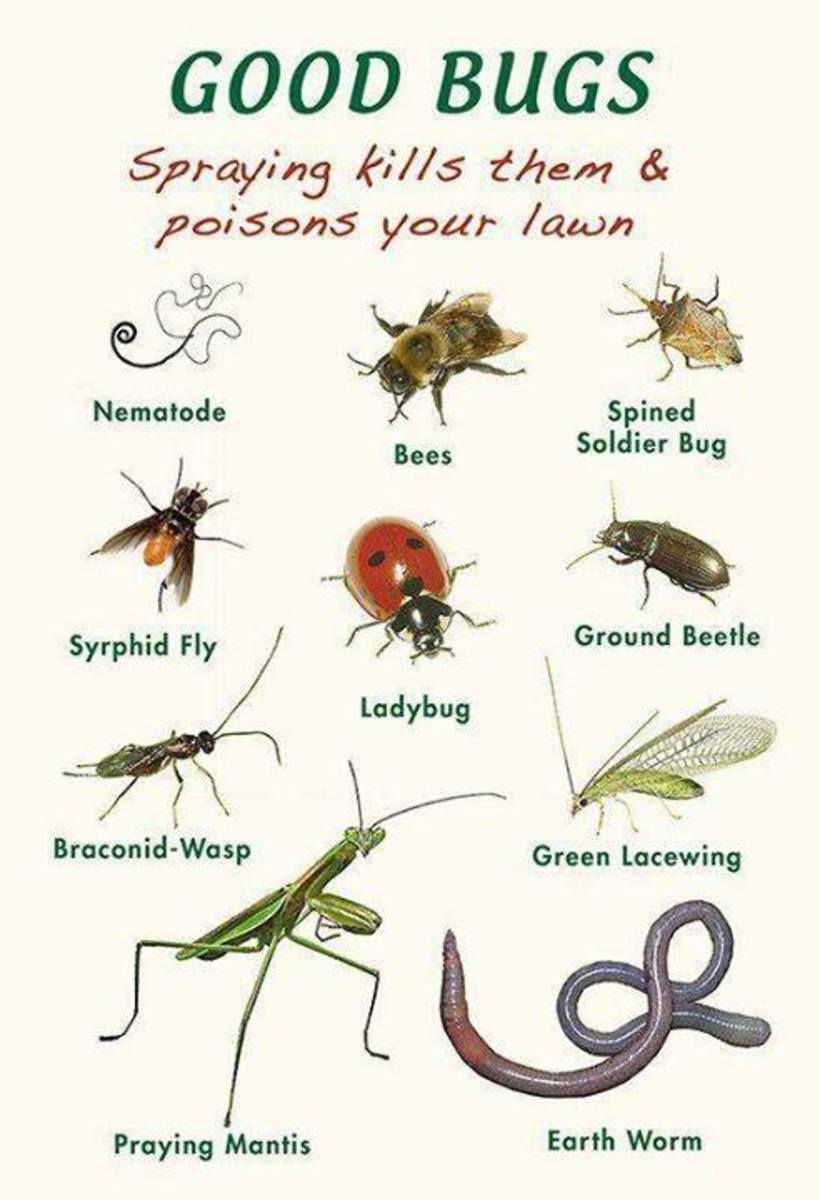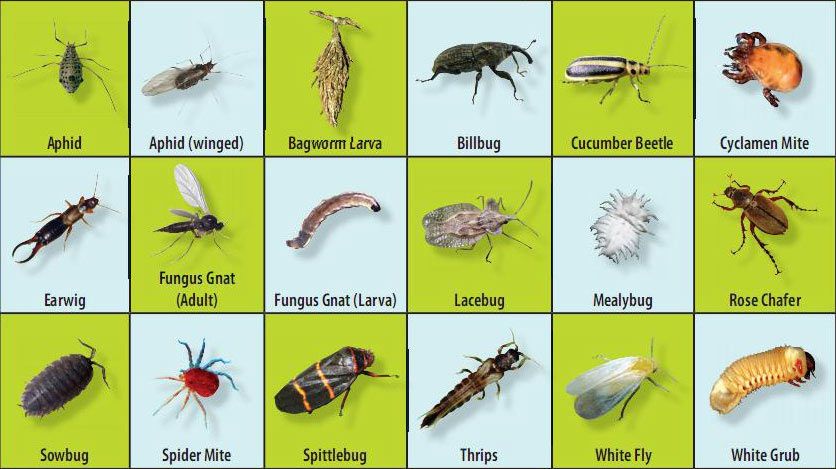Belcarra Garden Club
BC, Canada

Good Bugs, Bad Bugs
by Nora Boekhout
This monthly meeting focused on the little critters sharing our gardens with us… particularly (but not exclusively) BUGS!
photo by Les Bramley |
Les started us off with impressive photos of a large Blue-eyed Darner dragonfly. Dragonflies are important predators of mosquitos and other unwanted insects! We all noticed a sad decline in visiting butterflies this year but there were mixed views on the number of bees present. As always, we all had many unwanted insect pests to deal with! Les had been investigating the brown marmorated stink bug and had discovered some excellent information on the BC Government website regarding identification. |
 (photo from multiple Pinterest sources) |
So… “good bugs, bad bugs” is a great topic for any gardener! Marilyn Holt, from Buckerfields, notes that beneficial insects should consist of predators, parasitoids, and pollinators. Did you know that lacewings are one of the most beneficial predators to have around? Ladybugs are probably our best known “good bug”, and they are voracious eaters in all stages of their lives. Bees, butterflies, ground beetles and bombardier beetles, centipedes, damselflies, hoverflies, spiders, and earthworms are all in this list of “beneficial critters”. |
|
Ladybugs with 26 or 28 spots are actually “bad” because they eat plants! Some nematodes may be employed to attack certain parasitic bacteria or in-soil larvae, but they can also drain plants of vital fluids! Although sowbugs (pillbugs) feed mainly on decaying organic matter, they may also feed on seedlings and young plants. While ants are generally considered a nuisance, especially when they are “grooming” aphids, they also act as nature’s garbage collectors. Earthworms, as we noted in a previous article, are of great benefit in our home gardens but unfortunately, they are having disastrous effects on our native forests. (See our article May 2022).
The real “Baddies” are numerous: aphids, apple worms, black vine beetles and chafer beetles, cabbage moths, carrot flies, cut worms, earwigs, fruit flies, fungus gnats, grasshoppers, hornworm caterpillars, leaf miners, mealy bugs, mosquitoes, slugs and snails, whiteflies, wireworms, and so much more! The Japanese Beetle is of huge concern lately, and you will notice that our neighbour, Port Coquitlam, as well as other local areas, are currently under a soil and plant restriction
What to do? Oh my! Les confided that he has a secret ally in his garden… garter snakes! Not all of us are so lucky (hmm?) but we can look to doing our best to attract the predators and being careful not to use chemicals that could harm them or our pollinators as well as our potential “victims”. Do NOT spray insecticides arbitrarily!

(photo from multiple Pinterest sources)
Safer’s BTK (Biological insecticide) was suggested by Marilyn Holt as a useful biological control. It is only for above ground insects, so is ineffective for larvae pests in the soil. It won’t hurt other things like bees or birds. You do have to do your homework, however, and make sure that the caterpillars you are trying to get rid of are not one of our precious butterflies or moths!
Better yet, is the concept of companion planting! There are many options here. Nasturtiums, chives, marigolds (for ants, wooly aphids, thrips, whiteflies), parsley (for carrot fly), lavender (for mosquitoes, nematodes), garlic (for Japanese beetle).
Homemade sprays can also be useful. Garlic is reported to repel aphids, ants, armyworms, beetles, borers, cabbage bugs, caterpillars, cutworms, mites, mosquitoes, slugs, termites, whiteflies! Wow, all these and vampires too!
In the end, do your best to use natural remedies (squish those aphids!)
and remember that your actions affect more than just that one creature who is "bugging you"!
"Give me spots on my apples, but leave me the birds and the bees, please!"
from Joni Mitchell's "The Big Yellow Taxi"
RELATED LINKS
Our own Belcarra Garden Club articles:
May 2022 Worms can compost, can you?
June 2022 Monarchs and Milkweed
January 2023 Slugs and Eggshells
May 2023 Ground Beetles and others
September 2023 Part 2 - Japanese Beetles
October 2023 - Invasive species: Hammerhead Worms
Garden Club Presentations (Nora's blog posts)
Good Bugs, Bad Bugs by Marilyn Holt – BC Fuchsia and Begonia Society (bcfuchsiasociety.com)
Here's a great PDF with photos of "Good bugs, bad bugs" from Marilyn Holt
Garden-Pests-Handout.pdf (bcfuchsiasociety.com)
Invasive Insects in the Lower Mainland by Diane Watson | PoCo Garden Club (wordpress.com)
Information from BC Invasives on the Japanese Beetle problem.
Japanese Beetle (Popillia japonica) Problem | PoCo Garden Club (wordpress.com)
Here are some great photos and posters of Japanese beetles and their "look alikes" from BC Invasives
https://pocogardenclub.wordpress.com/2023/08/16/japanese-beetle-popillia-japonica-problem/
Here are some Garden Allies!
Know Your Garden Allies by Renee Prasad | PoCo Garden Club (wordpress.com)
Downloadable pamphlet on local beneficial insects etc. in your garden
WSU Extension Publications|Beneficial Insects, Spiders, and Mites in Your Garden: Who they are and how to get them to stay (Home Garden Series)
Butterflies in our Gardens by Hendrik Meekel – BC Fuchsia and Begonia Society (bcfuchsiasociety.com)
https://www.bcfuchsiasociety.com/honeybees-and-mason-bees-by-winston-wong/
Companion Planting by Lori Greyell | PoCo Garden Club (wordpress.com)
Other Links on the Internet
Japanese beetle - Invasive Species Council of British Columbia (bcinvasives.ca)
Brown marmorated stink bug - Invasive Species Council of British Columbia (bcinvasives.ca)
Photos of Pest Insects and Beneficial Bugs
https://www.saferbrand.com/advice/insect-library\
The Good, the Bad, and the Bugly (or How to Hire an Assassin)
https://dengarden.com/gardening/The-Good-The-Bad-and-The-Bugly
Beneficial Look-alikes
Beneficial Look-a-Likes | NC State Extension (ncsu.edu)
Companion Planting
https://www.thrive.org.uk/get-gardening/companion-planting
18 Plants that repel insects - The Spruce
https://www.thespruce.com/plants-that-repel-insects-4142012
Complete Companion Gardening Guide - Gardenia
Complete Companion Planting Guide: Plant the right plants together (gardenia.net)
Companion Planting
https://ahealthylifeforme.com/companion-planting-in-the-vegetable-garden/
Homemade garlic spray
https://biopests.com/is-garlic-a-good-pesticide-does-it-really-work/
Ants – good and bad
https://leafyplace.com/ants-in-the-garden/
Diatomaceous earth link
https://www.ruralsprout.com/diatomaceous-earth/
Fungus gnats
https://www.epicgardening.com/fungus-gnats/
Hover flies
https://www.gardeningknowhow.com/garden-how-to/beneficial/hover-flies-in-gardens.htm
Lacewings
https://www.ruralsprout.com/lacewings/
Lacewings – make a lacewing home DIY
https://www.gardenersworld.com/how-to/grow-plants/create-a-lacewing-home/
Ladybugs
https://dengarden.com/gardening/Ladybugs-They-Can-Keep-Your-Flowers-and-Plants-Pest-Free
Marmorated stink bugs
https://www.ontario.ca/page/brown-marmorated-stink-bug
Spined soldier bugs
https://www.gardeningknowhow.com/garden-how-to/beneficial/spined-soldier-bug-information.htm
Systemic pesticides
https://www.gardeningknowhow.com/plant-problems/pests/pesticides/systemic-pesticide-in-gardens.htm
Whiteflies
https://www.almanac.com/pest/whiteflies
Around the Garden with Les Bramley
|